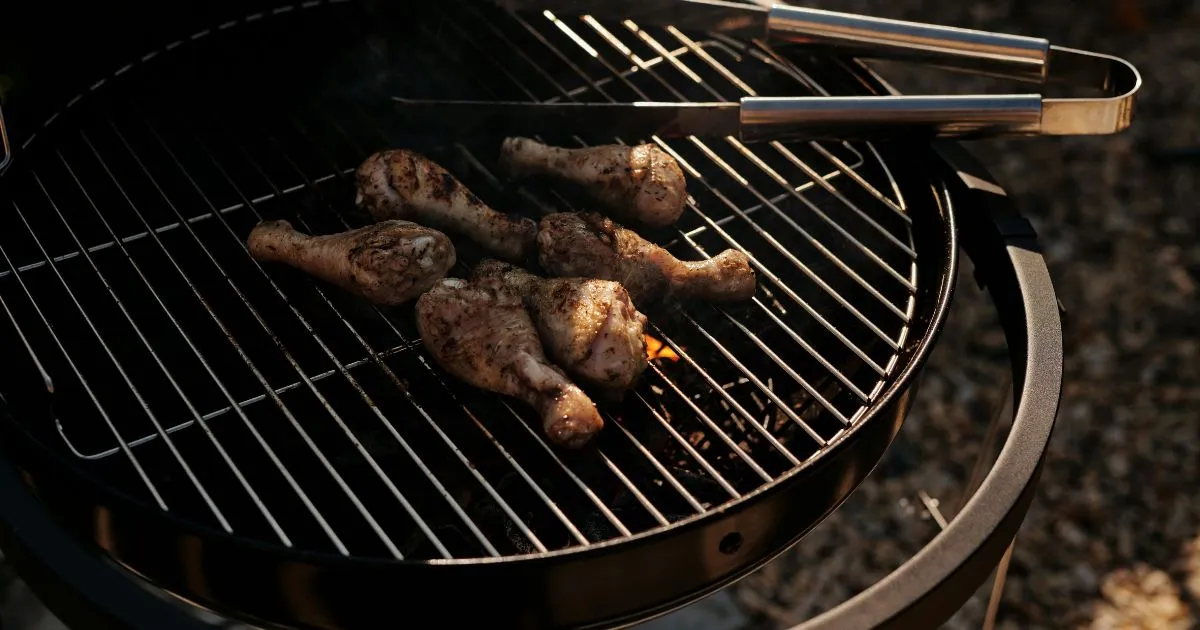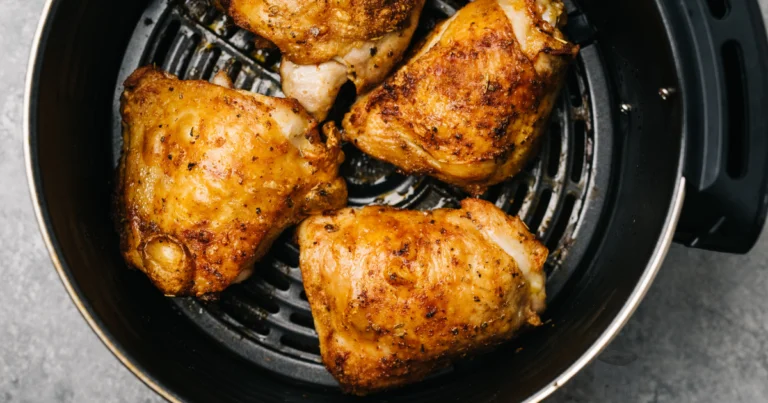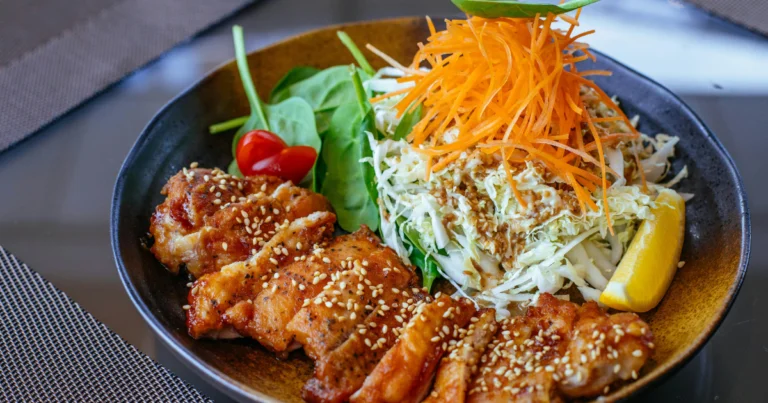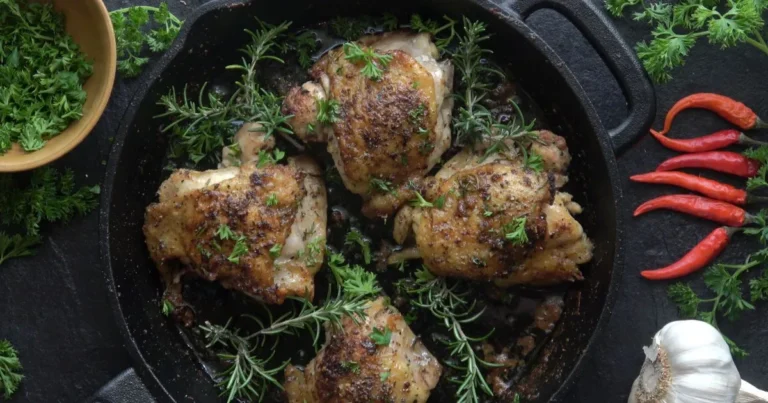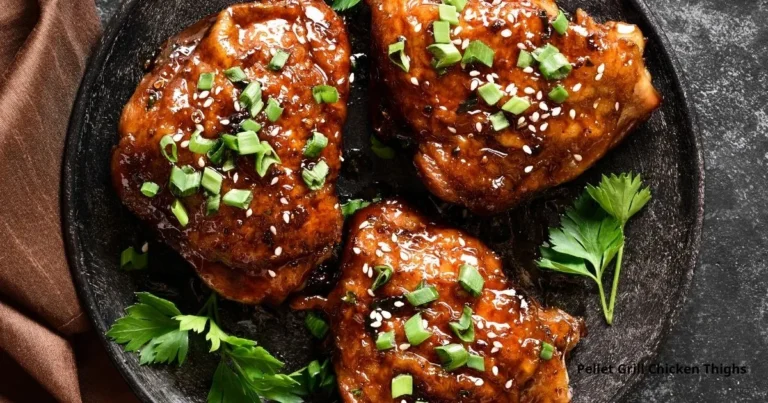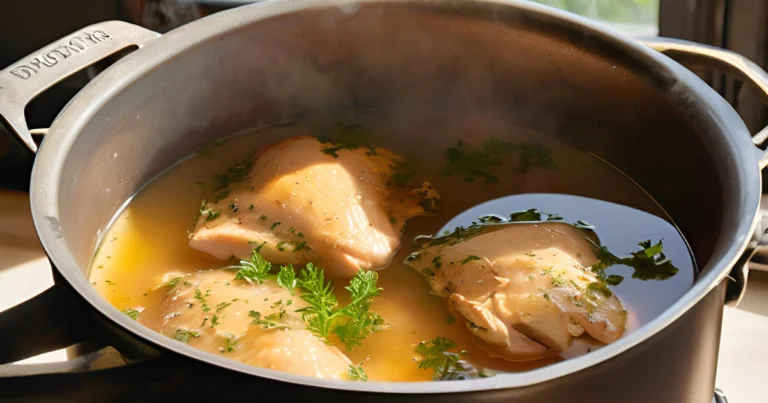How long to grill bone in chicken thighs evenly
how long to grill bone in chicken thighs
grill bone in chicken thighs isn’t just about slapping some meat on the grates and hoping for the best. It’s an art, requiring a balance of heat, timing, and technique. The bone presents both a challenge and an opportunity: it slows cooking and contributes to flavor and moisture retention. You can achieve perfectly grilled, juicy chicken thighs every time with patience and a thoughtful approach. Let’s uncover the nuances of mastering this process.
Table of Contents
What Makes Bone-In Chicken Thighs Different from Boneless?
How the Bone Affects Cooking Time and Heat Distribution
The presence of the bone alters how heat travels through the meat. Bones act as a heat insulator, slowing the cooking process in the areas closest to them. This requires a longer cook time to ensure the meat is done evenly from the inside out. In contrast to boneless cuts, bone-in thighs need a consistent heat source and more attentive grilling. Neglect this, and you’ll end up with a chicken thigh that’s burned on the outside yet undercooked near the bone.
Why Bone-In Thighs Offer Better Flavor and Moisture
Bone-in chicken thighs bring more than structural integrity to the table—they offer a richer flavor profile. As the meat cooks, marrow within the bone seeps into the surrounding flesh, adding depth to the taste. Additionally, the slower cooking process helps retain moisture, resulting in succulent, tender meat that’s less likely to dry out. The skin on bone-in thighs also crisps up beautifully when prepared correctly, enhancing the overall texture.
The Importance of Prepping Your Chicken for Even Grilling
Should You Use a Marinade, Dry Rub, or Brine?
Preparation plays a critical role in how well your chicken thighs cook and taste. Marinades introduce moisture and flavor through acidic components like vinegar or citrus, but they require several hours to penetrate the meat. Dry rubs, on the other hand, concentrate on creating a flavorful crust, ideal for those who enjoy a spiced, crispy skin. For the juiciest results, a brine solution—made of salt, sugar, and water—helps break down muscle fibers and lock in moisture during grilling.
Tips for Patting Dry the Skin for a Crispy Finish
A crispy skin starts with a simple but often overlooked step: patting the chicken dry with paper towels. Excess moisture on the skin prevents it from crisping up, leading to soggy, rubbery results. Once the skin is dry, a light coat of oil and seasoning will further enhance the crisping process.
Choosing the Right Grill and Heat Setup for Bone-In Thighs
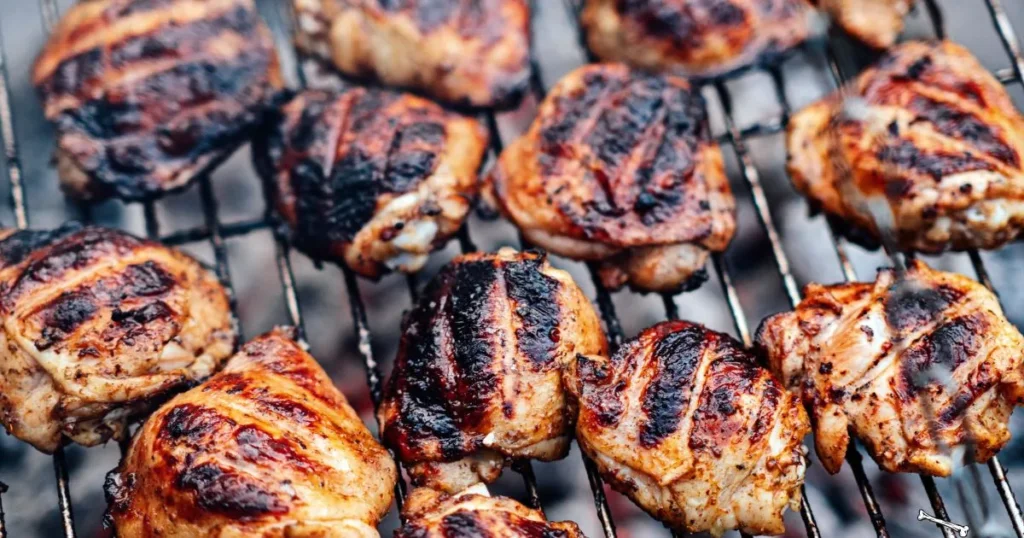
Gas or Charcoal: Which Works Best?
While both gas and charcoal grills can deliver excellent results, they offer distinct advantages. Gas grills provide precise heat control, making it easier to maintain steady temperatures. Charcoal grills, on the other hand, impart a smoky flavor that complements the richness of bone-in chicken thighs. The choice ultimately depends on whether you prioritize convenience or taste.
How to Set Up a Two-Zone Fire for Precise Heat Control
A two-zone fire is essential for grilling bone-in thighs evenly. One side of the grill should be set to high heat for searing, while the other side maintains a lower temperature for indirect cooking. This arrangement lets you start the thighs over direct heat to get a nice sear, then move them to indirect heat to cook through without burning the skin.
How Long to Grill Bone-In Chicken Thighs at Different Heat Levels
Low and Slow vs. Hot and Fast: Which Method Works Better?
Cooking low and slow—at temperatures around 300°F—ensures even cooking and maximum moisture retention. However, the hot-and-fast method, with temperatures closer to 450°F, creates a crispier skin but requires more vigilance to prevent burning. A hybrid approach, searing first and then finishing over indirect heat, strikes a perfect balance.
Estimated Cooking Times for Medium, High, and Indirect Heat
For medium heat (350°F), expect a cooking time of 30-35 minutes. At high heat (450°F), chicken thighs can be done in as little as 20 minutes. If using indirect heat at 300°F, plan for about 40-50 minutes, turning occasionally. Always rely on a thermometer for accuracy, rather than just cooking times.
Mastering the Flip: How Often Should You Turn Chicken Thighs?
The One-Flip Rule vs. Frequent Turning: Which to Follow?
Some grillers swear by the “one-flip rule,” turning the chicken just once for even cooking. Others prefer frequent flipping, believing it prevents burning and promotes even browning. The ideal approach depends on your heat source. On a hot grill, multiple flips help prevent flare-ups, while a more stable heat may benefit from minimal flipping.
Signs It’s Time to Flip Without Breaking the Skin
Look for clear grill marks and a slight release from the grates as indicators that it’s time to flip. If the skin sticks, it likely isn’t ready yet. Patience is key—forceful flipping can tear the skin, ruining both the appearance and texture.
Target Internal Temperature: The Key to Safe and Juicy Thighs
Why 165°F is the Safe Internal Temperature for Chicken
Chicken must reach an internal temperature of 165°F to ensure it’s safe to eat. Anything below this risks harmful bacteria, while overcooking can lead to dryness. Bone-in thighs, however, remain moist even when slightly above this temperature, so hitting 170-175°F is ideal for tenderness.
How to Use a Meat Thermometer Without Touching the Bone
Insert the thermometer probe into the thickest part of the thigh, avoiding the bone. If the probe touches the bone, it will give a false reading, indicating a higher temperature than the meat’s actual doneness.
How to Prevent Flare-Ups and Hot Spots for an Even Cook
Managing Fat Drippings Without Losing Heat
As chicken thighs cook, fat drips onto the flames, causing flare-ups. Move the chicken to the cooler side of the grill if flames become uncontrollable. Alternatively, keep a squirt bottle of water on hand to tame minor flare-ups without disrupting the cooking process.
Identifying and Adjusting for Hot Spots on Your Grill
Every grill has its quirks, including uneven heat distribution. Test for hot spots by placing bread slices on the grates and observing which brown the fastest. Once identified, rotate the chicken thighs as needed to ensure uniform cooking.
What to Do If Your Thighs Cook Unevenly: Quick Fixes
Rotating Thighs for Even Cooking Across Zones
If one side of the thigh is cooking faster, rotate it to a cooler part of the grill. Continuously monitor and adjust to ensure consistent doneness throughout.
Adjusting the Grill Lid for Temperature Control
Leaving the grill lid open allows heat to escape, slowing down cooking. Closing the lid traps heat, promoting even cooking. Use the lid strategically based on the grill temperature and desired cook time.
Resting the Chicken: Why It’s Crucial and How Long to Wait
How Resting Enhances Juiciness and Locks in Flavors
Resting allows the juices to redistribute within the meat, preventing them from spilling out upon cutting. This simple step ensures each bite is flavorful and moist.
The Ideal Resting Time for Bone-In Thighs
Allow the chicken to rest for 5-10 minutes after grilling. Covering it loosely with foil keeps the thighs warm while they rest without trapping steam, which could soften the skin.
Serving and Pairing Ideas: Elevate Your Grilled Chicken Thighs
Best Side Dishes and Sauces for BBQ Chicken
Pair your grilled chicken thighs with classic sides like coleslaw, grilled vegetables, or cornbread. Add a smoky BBQ sauce or a tangy chimichurri to complement the rich flavors.
Beverage Pairings: From Beer to Lemonade for a Perfect Meal
A crisp lager or a zesty lemonade pairs beautifully with grilled chicken, enhancing the smoky undertones. For a bolder pairing, try a dry rosé or iced tea with mint.
Conclusion: Grilling Bone-In Chicken Thighs Evenly Every Time
Consistency is the hallmark of great grilling. By mastering heat control, flipping techniques, and resting time, you’ll unlock the secret to perfectly grilled bone-in chicken thighs. Don’t be afraid to experiment with flavors and grilling methods. The pleasure of cooking comes from the journey just as much as the final result .
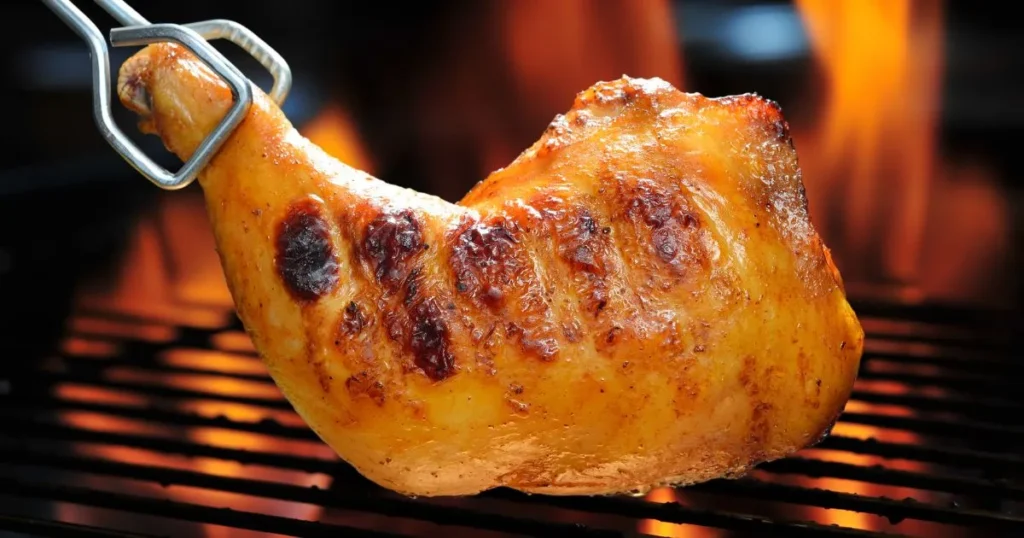
(FAQs)
1. How long does it take to grill bone-in chicken thighs?
Grilling bone-in chicken thighs typically takes 30-40 minutes over medium heat (around 350°F) or 20-25 minutes on high heat (450°F). If using indirect heat at lower temperatures, expect 40-50 minutes. Always rely on a meat thermometer to confirm doneness.
2. What temperature should bone-in chicken thighs reach?
The internal temperature of bone-in chicken thighs should reach at least 165°F for safety, but cooking them to 170-175°F ensures maximum tenderness and flavor.
3. Should I use direct or indirect heat for bone-in chicken thighs?
A combination works best: start with direct heat to sear the skin, then move to indirect heat to finish cooking evenly without burning the exterior.
4. How do I keep chicken thighs from drying out on the grill?
Using a marinade or brine helps retain moisture. Additionally, cooking over indirect heat and allowing the meat to rest after grilling ensures juiciness.
5. How often should I flip bone-in chicken thighs?
Flip the thighs every 5-7 minutes when using medium or high heat. Frequent flipping helps prevent flare-ups and ensures even browning without tearing the skin.
6. What causes flare-ups when grilling chicken thighs?
Flare-ups occur when fat drips onto the flames. Manage this by grilling over indirect heat, trimming excess fat, and using a squirt bottle to control minor flames.
7. How do I know when it’s time to flip the chicken thighs?
Look for distinct grill marks and a slight release from the grates. If the skin sticks, give it more time—forcing a flip too soon can tear the skin.
8. Can I use a gas grill instead of charcoal?
Yes, gas grills offer better heat control and are easier to manage. However, charcoal grills add a smoky flavor that enhances the taste of bone-in thighs.
9. Do I need to let the chicken rest after grilling?
Yes, letting the chicken rest for 5-10 minutes allows the juices to redistribute, making the meat more flavorful and tender.
10. What sides and sauces go well with grilled chicken thighs?
Popular sides include coleslaw, grilled vegetables, cornbread, and potato salad. Complementary sauces include BBQ, chimichurri, and honey mustard.

